
When the last leaves drop and flowers are long gone, the garden is stripped back to its essentials. Shapes, textures, and the play of light on bare stems become the main actors. In this pared-down season, fiery-stemmed shrubs step into the spotlight. Their branches burn with color — scarlet, orange, gold — and seem to glow all the brighter for the quiet landscape around them.
I’ve always found these plants to be a source of delight on cold mornings. The way frost settles on a red stem, or how low sunlight sets a thicket ablaze, can transform even the smallest corner into something worth pausing for. It’s proof that winter gardens aren’t empty at all; they are simply distilled, reduced to the details that matter most.
The beauty of shrubs with colored stems is how easily they fit into ordinary spaces. You don’t need a grand estate or a special “winter garden.” A few well-chosen shrubs woven into a border can give months of interest when little else is happening. They provide structure, contrast, and a quiet kind of drama that lasts right through to March.
Planted now, while the soil is still warm, they’ll root quickly and be ready to flare into color by next winter. Here are ten of the finest shrubs for fiery winter stems — reliable, striking, and guaranteed to bring light to the darkest season.
1: Red Twig Dogwood (Cornus sericea)

Few shrubs rival redtwig dogwood for sheer winter drama. Its young stems shine a vivid crimson, glowing brightest when framed by frost or snow. Through the rest of the year, it offers lush green foliage, clusters of white spring flowers, and late-summer berries that birds adore. But it’s in winter—when most of the garden lies dormant—that this shrub reveals its true brilliance.
October is the perfect time to plant redtwig dogwoods. The soil still holds warmth from summer, encouraging strong root growth before winter sets in. By spring, the shrubs will be well established, ready to burst with new shoots that turn brilliant red by next fall. I like to set them in groups along the edge of a border or near a path—the effect, once winter light hits the stems, is like a line of glowing beacons guiding you through the garden.
When to Plant: Plant in October or early spring. Container-grown plants can be set out year-round, but autumn planting gives them the best start.
Growing Conditions: Thrives in a wide range of soils, even damp or heavy ground. Prefers full sun for the brightest stem color but tolerates light shade.
Hardiness: USDA zones 2–7.
Season of Interest: White flowers in spring, berries in summer, and vivid crimson stems from late fall through early spring.
2: Tatarian Dogwood (Cornus alba ‘Sibirica’)
Tatarian dogwood is one of those shrubs that proves its worth in the quietest season. Its stems glow in fiery shades of red with a warm orange undertone, creating a striking silhouette once the leaves have fallen. In summer, it’s a full, leafy shrub with clusters of small white flowers and pale berries for the birds. But in winter, it strips down to a fire-colored skeleton that stands out brilliantly against frost or snow.
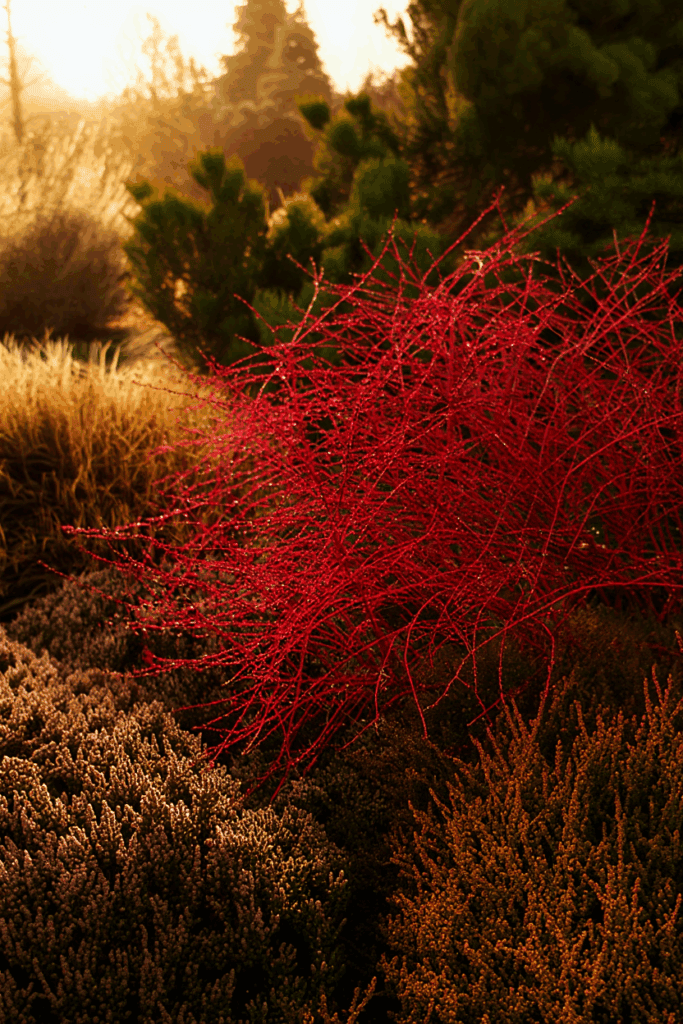
I like planting it near evergreens—the contrast of deep green and flame-red never fails to lift a garden scene in January. It’s also remarkably easy-going, thriving in damp soil or clay where other shrubs sulk.
When to Plant: Best in fall or early spring, though container-grown plants can be set out most of the year with regular watering.
Growing Conditions: Tolerates a wide range of soils, including heavy clay and damp ground. Grows in sun or part shade, though the stems show their brightest color in full sun.
Hardiness: USDA zones 3–7.
Season of Interest: White flowers in spring, berries in summer, and fiery stems from late fall through early spring.
3: Midwinter Fire Dogwood (Cornus sanguinea ‘Midwinter Fire’)
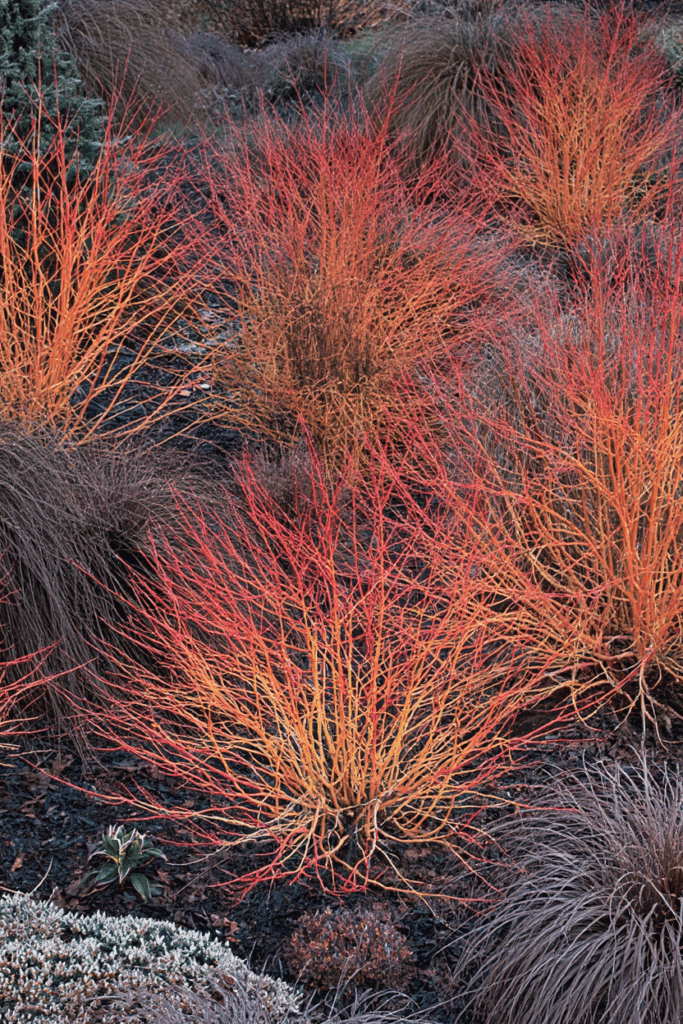
This shrub lives up to its name, with stems that glow in bands of golden yellow, amber, and fiery red—like a winter sunset frozen in place. In summer it’s modest, with green leaves and small flowers, but once the foliage drops, it transforms into a fountain of flame. In the low light of January, the stems can look as though candles are burning quietly in the border.
October is the perfect time to plant ‘Midwinter Fire.’ The soil’s residual warmth encourages strong roots, which means more vigorous young shoots by spring—the ones that turn brightest the following winter. I like to place it where the low sun can shine through from behind; on frosty mornings, the stems glow as if they’ve been lit from within.
When to Plant: October or early spring; autumn planting gives the strongest start.
Growing Conditions: Tolerant of most soils, even heavy ground. Prefers full sun for the richest stem color, though partial shade is acceptable.
Hardiness: USDA zones 4–7.
Season of Interest: Green summer foliage, followed by stems that blaze yellow, orange, and red from late fall to early spring.
4: Golden Willow (Salix alba ‘Britzensis’)
Golden willow is grown not for its spring catkins, but for its gleaming golden-orange stems that brighten the dullest winter day. Tall and vigorous, it shines against gray skies and is especially effective near ponds or low ground where moisture lingers. Its upright stems catch the faintest winter light, creating a warm glow even in the bleakest months.
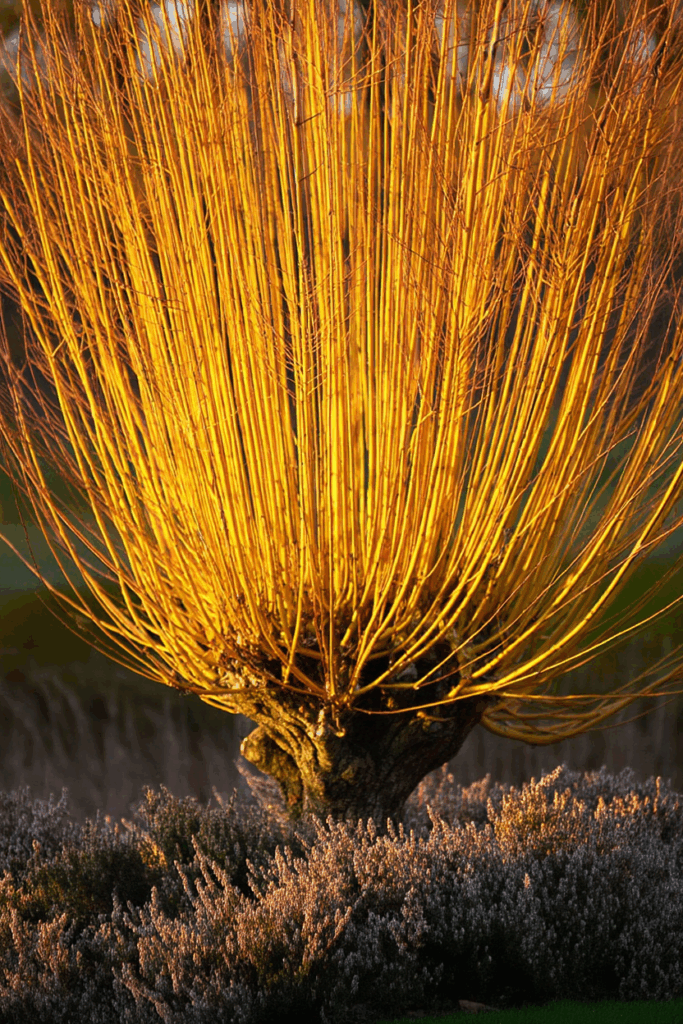
October planting suits willows perfectly—they root quickly in cool, moist soil and establish before the ground freezes. By next year, you’ll have a thicket of fresh shoots that gleam brightest when coppiced regularly. I often recommend planting golden willow as a bold backdrop to ornamental grasses or red-stemmed dogwoods; the contrast of fiery shades adds depth and texture to winter plantings.
When to Plant: October is ideal; also early spring if soil is workable.
Growing Conditions: Thrives in damp, moisture-retentive soil. Best in full sun for the strongest stem color.
Hardiness: USDA zones 4–8.
Season of Interest: Golden-orange stems in winter, with fresh green foliage in spring and summer.
5: Flame Willow (Salix ‘Flame’)

True to its name, Flame willow glows in fiery shades of deep orange and red, creating a striking display through the heart of winter. Planted in groups, its upright stems look like a bonfire flickering in the border—especially dramatic when paired with soft plumes of ornamental grasses swaying in the cold wind.
Fall is the best time to establish Flame willow. It roots quickly in cool, moist soil and sends up vigorous shoots by spring, which will turn into next year’s glowing stems. Because its color is most effective in numbers, I like to plant it in threes or fives, where the blaze of orange-red becomes impossible to miss.
When to Plant: October or early spring; autumn planting gives the best start.
Growing Conditions: Tolerates most soils, but thrives in moist, well-drained ground. Prefers full sun for richest winter color.
Hardiness: USDA zones 4–8.
Season of Interest: Glowing orange-red stems from late fall into early spring; lush foliage in summer.
6: Japanese Coral Bark Maple (Acer palmatum ‘Sango-kaku’)

Although often grown as a small tree, Japanese coral bark maple can also be pruned into a large shrub, making it an elegant addition to the winter garden. Its stems blush coral pink to red, offering a luminous contrast against bare branches and snow. Come spring, delicate green leaves unfurl, carrying the plant gracefully through the seasons.
October is an excellent time to plant this maple. The soil is still warm enough to encourage root growth before winter, giving it a strong foundation. I love to site it where it catches the morning sun—the coral stems glow even brighter when bathed in soft, slanting light.
When to Plant: Best in fall or early spring. Avoid planting in hot midsummer conditions.
Growing Conditions: Prefers fertile, well-drained soil; thrives in partial sun or dappled shade. Protect from harsh winds.
Hardiness: USDA zones 5–8.
Season of Interest: Coral-red stems in winter, soft green leaves in spring and summer, often turning golden-yellow in autumn.
7. Arctic Fire® Dogwood (Cornus stolonifera ‘Farrow’)
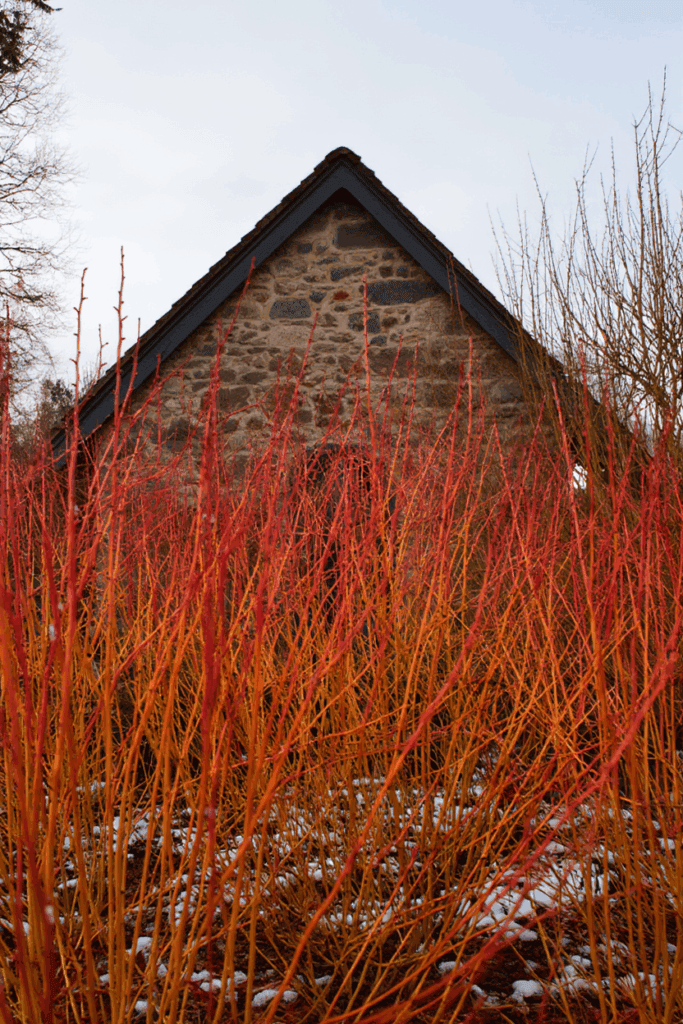
Compact yet brilliant, Arctic Fire® is a modern selection of red osier dogwood bred for smaller gardens. Its stems glow a rich scarlet-red in winter, but the shrub stays a tidy 4–5 feet tall—making it perfect for borders, foundation plantings, or even containers. In summer, it offers clusters of white flowers followed by berries that birds enjoy, but its real star turn is in the stark landscape of midwinter.
I’ve always found this variety especially useful where space is tight. You get all the drama of a classic red osier without the thicket-forming sprawl. Planted in groups, Arctic Fire® can look like a series of glowing torches when the low sun hits the stems.
When to Plant: Best in fall for quick establishment, but spring planting works well too.
Growing Conditions: Adaptable to clay, damp ground, or average garden soils. Full sun ensures the deepest stem color.
Hardiness: USDA zones 3–7.
Season of Interest: White flowers in summer, followed by bright red stems from late fall through early spring.
8. Bloodtwig Dogwood (Cornus sanguinea ‘Winter Flame’)

‘Winter Flame’ is one of the most dramatic stem-color dogwoods available, with stems that shift in color from golden yellow at the base to fiery orange and red at the tips. The gradient effect creates the illusion of a glowing fire in the garden border—an effect that’s magnified when several shrubs are planted together.
This is one of those shrubs that catches the eye even on the darkest winter days. Planted near evergreens or ornamental grasses, its flame-colored stems look even more intense, as though the border itself is lit from within.
When to Plant: Fall planting gives the best start, though it can also be planted in early spring.
Growing Conditions: Thrives in moist, fertile soil but adapts easily to average conditions. Full sun produces the richest blend of color.
Hardiness: USDA zones 5–7.
Season of Interest: Yellow-to-red stems glowing from late fall until early spring.
9. Scarlet Willow (Salix alba var. vitellina ‘Britzensis’)

Scarlet willow earns its name with stems that blaze a fiery orange-red through the depths of winter. Taller and more upright than some other willows, it creates a bold, architectural presence in the landscape. In frost or snow, the stems seem to glow from within, making it one of the most dramatic willows for winter color.
One winter I saw a stand of scarlet willow lining a frozen pond, and it looked like the ice itself was edged with flame. It’s especially effective in groups, where the fiery stems can transform a dull corner into a focal point.
When to Plant: Best in fall, though early spring planting also works.
Growing Conditions: Thrives in moist or damp soils, tolerates clay, and prefers full sun.
Hardiness: USDA zones 4–8.
Season of Interest: Fiery orange-red stems from late fall through early spring.
10. Rubus cockburnianus (White-stemmed Bramble)
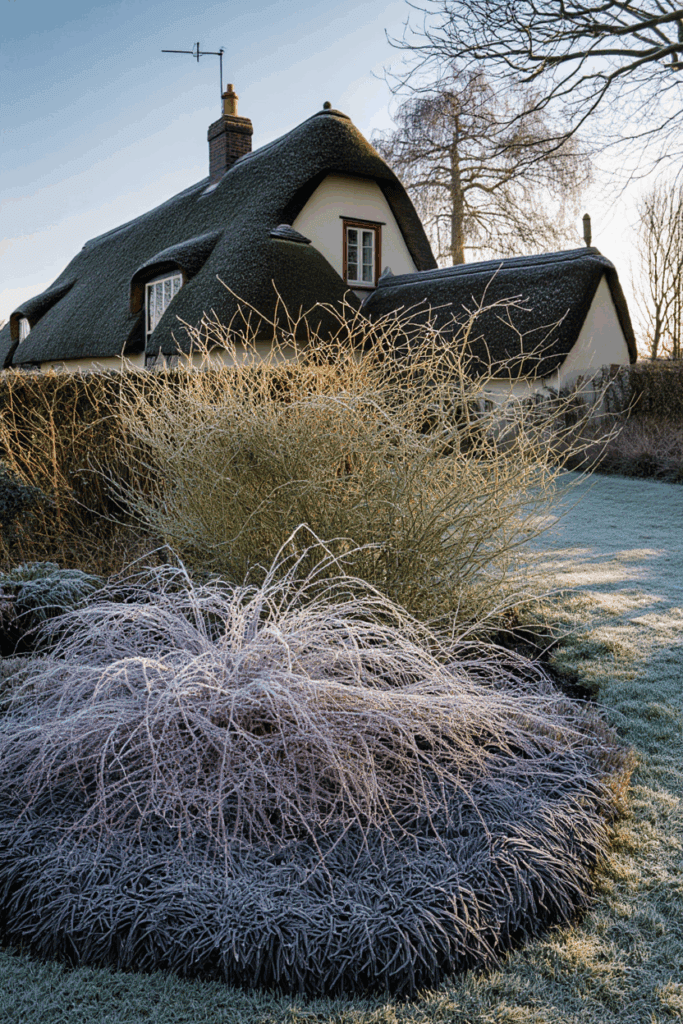
Rubus cockburnianus is an ornamental bramble grown for its chalky white stems that glow once the leaves have fallen. In winter light, the arching canes seem almost luminous, standing out against evergreens or the soft grey of frost. In summer, it’s a leafy green shrub, but when stripped back in the cold months, its ghostly framework takes on an elegance that feels both unexpected and striking.
What I love about this plant is the way it can lift a quiet corner of the garden. A clump of freshly pruned stems, shining pale against darker backgrounds, adds an almost sculptural quality. Unlike wild brambles, it isn’t unruly if managed well, and pruning each year not only refreshes the display but also gives you long, pale stems that can even be woven into rustic supports.
When to Plant: Best in autumn for quick establishment, though spring planting also works well.
Growing Conditions: Fertile, well-drained soil; prefers full sun but will tolerate partial shade.
Hardiness: USDA zones 5–8.
Season of Interest: Soft green foliage in summer; brilliant white stems glowing from late fall through early spring.
Pruning for Winter Stems
The youngest stems always show the brightest color, so pruning is essential if you want shrubs to keep their fiery glow year after year.
- For vigorous dogwoods (Cornus alba, C. sanguinea): Once the plants are a couple of years old, cut all stems hard back to just above ground level each March, just before buds break. This encourages a flush of fresh shoots that will blaze with color the following winter.
- For less vigorous varieties (such as the orange-toned ‘Midwinter Fire’): Allow them time to establish before pruning. Then, prune more gently — every two or three years — or remove only a portion of the oldest stems at a time. This ensures a steady supply of colorful young growth while keeping structure in place.
- For added height and interest: Instead of cutting right to the ground, try “stooling” — leaving a short trunk from which new stems will sprout. This creates layers of color at different levels in the border.
Always use sharp loppers or a pruning saw to make clean cuts, avoiding snags. After pruning, give shrubs a boost with a balanced fertilizer such as blood, fish, and bone, and mulch around the base to lock in moisture. If stems are flexible enough, save the prunings — they can be woven into rustic plant supports or even seasonal wreaths.

Written By
Amber Noyes
Amber Noyes was born and raised in a suburban California town, San Mateo. She holds a master’s degree in horticulture from the University of California as well as a BS in Biology from the University of San Francisco. With experience working on an organic farm, water conservation research, farmers’ markets, and plant nursery, she understands what makes plants thrive and how we can better understand the connection between microclimate and plant health. When she’s not on the land, Amber loves informing people of new ideas/things related to gardening, especially organic gardening, houseplants, and growing plants in a small space.
